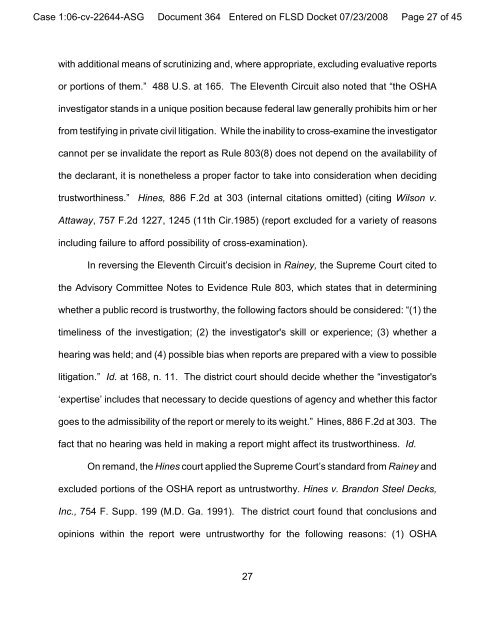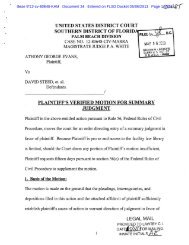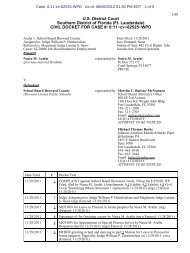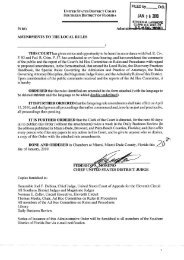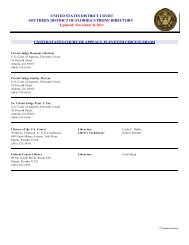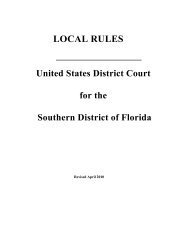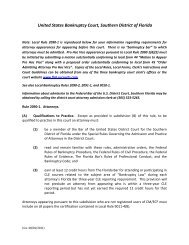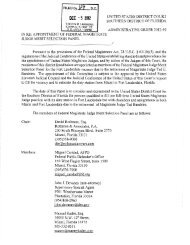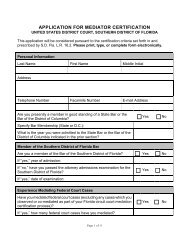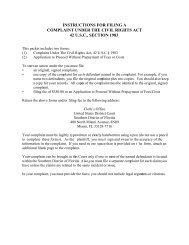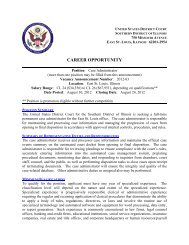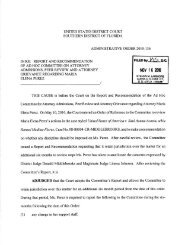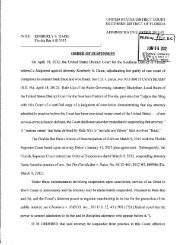Motion in Limine - United States District Court
Motion in Limine - United States District Court
Motion in Limine - United States District Court
Create successful ePaper yourself
Turn your PDF publications into a flip-book with our unique Google optimized e-Paper software.
Case 1:06-cv-22644-ASG Document 364 Entered on FLSD Docket 07/23/2008 Page 27 of 45<br />
with additional means of scrut<strong>in</strong>iz<strong>in</strong>g and, where appropriate, exclud<strong>in</strong>g evaluative reports<br />
or portions of them.” 488 U.S. at 165. The Eleventh Circuit also noted that “the OSHA<br />
<strong>in</strong>vestigator stands <strong>in</strong> a unique position because federal law generally prohibits him or her<br />
from testify<strong>in</strong>g <strong>in</strong> private civil litigation. While the <strong>in</strong>ability to cross-exam<strong>in</strong>e the <strong>in</strong>vestigator<br />
cannot per se <strong>in</strong>validate the report as Rule 803(8) does not depend on the availability of<br />
the declarant, it is nonetheless a proper factor to take <strong>in</strong>to consideration when decid<strong>in</strong>g<br />
trustworth<strong>in</strong>ess.” H<strong>in</strong>es, 886 F.2d at 303 (<strong>in</strong>ternal citations omitted) (cit<strong>in</strong>g Wilson v.<br />
Attaway, 757 F.2d 1227, 1245 (11th Cir.1985) (report excluded for a variety of reasons<br />
<strong>in</strong>clud<strong>in</strong>g failure to afford possibility of cross-exam<strong>in</strong>ation).<br />
In revers<strong>in</strong>g the Eleventh Circuit’s decision <strong>in</strong> Ra<strong>in</strong>ey, the Supreme <strong>Court</strong> cited to<br />
the Advisory Committee Notes to Evidence Rule 803, which states that <strong>in</strong> determ<strong>in</strong><strong>in</strong>g<br />
whether a public record is trustworthy, the follow<strong>in</strong>g factors should be considered: “(1) the<br />
timel<strong>in</strong>ess of the <strong>in</strong>vestigation; (2) the <strong>in</strong>vestigator's skill or experience; (3) whether a<br />
hear<strong>in</strong>g was held; and (4) possible bias when reports are prepared with a view to possible<br />
litigation.” Id. at 168, n. 11. The district court should decide whether the “<strong>in</strong>vestigator's<br />
‘expertise’ <strong>in</strong>cludes that necessary to decide questions of agency and whether this factor<br />
goes to the admissibility of the report or merely to its weight.” H<strong>in</strong>es, 886 F.2d at 303. The<br />
fact that no hear<strong>in</strong>g was held <strong>in</strong> mak<strong>in</strong>g a report might affect its trustworth<strong>in</strong>ess. Id.<br />
On remand, the H<strong>in</strong>es court applied the Supreme <strong>Court</strong>’s standard from Ra<strong>in</strong>ey and<br />
excluded portions of the OSHA report as untrustworthy. H<strong>in</strong>es v. Brandon Steel Decks,<br />
Inc., 754 F. Supp. 199 (M.D. Ga. 1991). The district court found that conclusions and<br />
op<strong>in</strong>ions with<strong>in</strong> the report were untrustworthy for the follow<strong>in</strong>g reasons: (1) OSHA<br />
27


